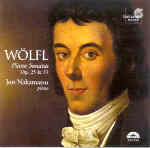Joseph Wölfl (1773-1812) was a younger contemporary of Beethoven whose considerable keyboard virtuosity and prolific creative output is all but unknown today. The C minor Op. 25 sonata makes large-scale demands on its interpreter: orchestral textures, meaty octaves that run the keyboard’s gamut, and an introductory fugue that needs all the projection and fingerpower it can get to make its heaven-storming (if rather academic) effects felt. By contrast, the three Op. 33 sonatas are more modest in scope if no less challenging from a pianistic standpoint.
The finale to the C major sonata can be described as Carl Maria von Weber’s Perpetuum Mobile without the memorable tunes. But the D minor sonata’s first movement is quite interesting. The exposition’s telling silences and ascending main theme are cut from the same cloth as Beethoven’s Tempest Sonata, yet the composer’s sly major/minor-key interplay easily could be mistaken for Schubert. And the lovely central Andante is a beautiful Mozart composition you’ve never heard before. Mozart’s theatrical ghost inspires the E major sonata’s vehement dotted motives that, however, beat their own virtuosic drum.
Jon Nakamatsu’s solid, energetic playing likely will win new listeners over to this unknown repertoire. He’s especially convincing when his fingers are fully occupied with disentangling fugal writing and bravura sequences. But I find myself predicting his interpretive choices before they occur, such as the way he lingers over second subjects, and how he slows down at certain cadence points or underlines a particular harmonic felicity. And I think his prettified, rather foursquare take on much of the D minor sonata’s aforementioned Allegro pays no heed to the music’s dramatic tension and dark undercurrents. All told, I hope Nakamatsu will continue giving attention to repertoire that has not been recorded umpteen times. How about some Anton Reicha next?
































